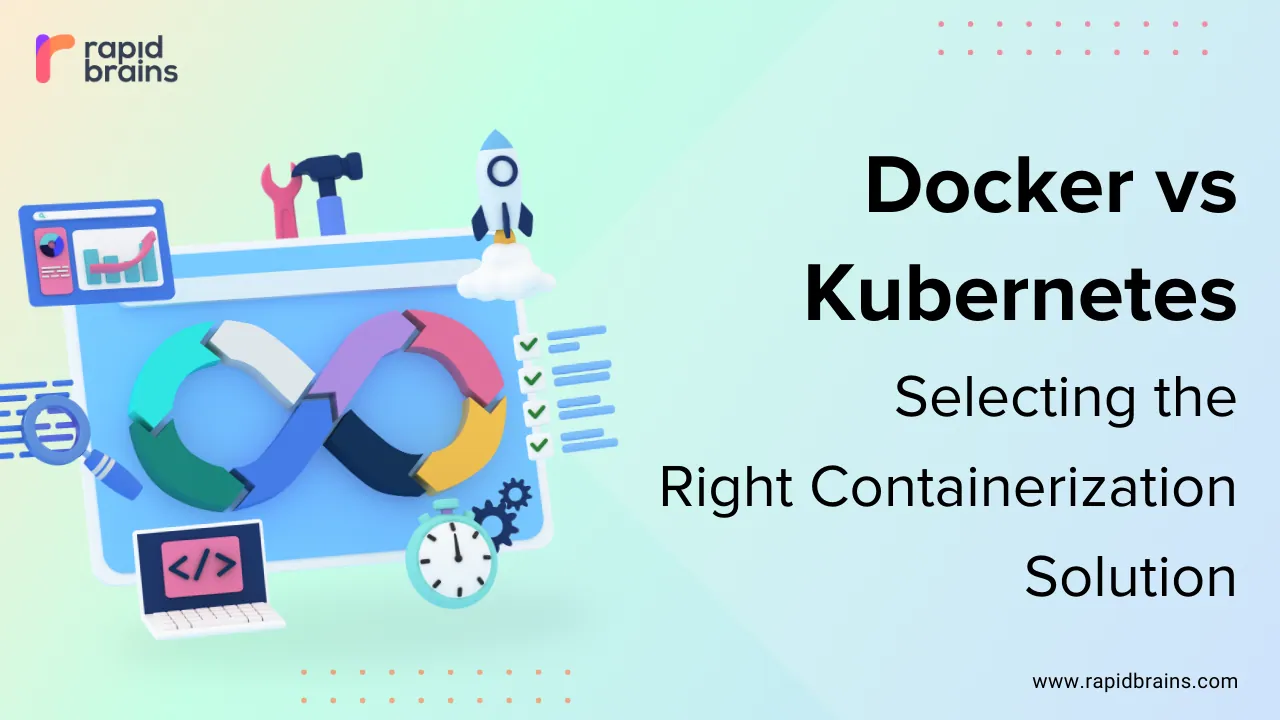
Introduction
The world of software development and deployment underwent a profound transformation with the advent of containerization. It has empowered organizations to streamline their processes by efficiently building, packaging, and distributing applications. Among the leading containerization solutions that reshaped the management of modern applications are Docker and Kubernetes. In this blog, we delve into the distinctions between Docker and Kubernetes, explore their respective use cases, and discuss essential considerations for selecting the ideal containerization solution tailored to your specific requirements.
What is a Docker?
Docker is an open-source platform that allows developersto automate the deployment, scaling, and management of applications inside lightweight, portable containers. It provides an efficient way to package an application and its dependencies into a standardized unit, called a Docker container. These containers can then run consistently on any environment that supports Docker, whether it is a developer’s local machine, a test server, or a production server in the cloud.
History Of Docker
The history of Docker as a developer tool is a fascinating journey that revolutionized the way applications are developed, packaged, and deployed. Let’s take a look at the key milestones in the history of Docker
Solomon Hykes’ Invention (2010-2013)
The roots of Docker can be traced back to 2010 when French entrepreneur Solomon Hykes initiated the dotCloud project. With the aim of creating an easy-to-use platform-as-a-service (PaaS) solution, he developed the “Shipyard” tool, which eventually evolved into Docker.
Birth of Docker (2013)
In March 2013, Solomon Hykes released the inaugural version of Docker as an open-source project during PyCon, a Python conference. Its innovative approach to containerization captivated the developer community, allowing applications and dependencies to be isolated within lightweight containers.
Docker, Inc. and Rapid Growth (2013-2014)
The exponential growth of Docker led to the establishment of Docker, Inc. in March 2013, supported by significant venture capital. This marked the official beginning of the Docker company, focused on further developing and promoting the Docker platform. The technology gained immense popularity, with developers and companies swiftly adopting it as their go-to containerization solution.
Docker’s Rise to Dominance (2014-2015)
In 2014, Docker solidified its position as the de facto standard for containerization. Major tech giants, including Google, Red Hat, and Microsoft, embraced Docker, integrating it into their cloud platforms and operating systems. The Docker community expanded exponentially, and Docker Hub emerged as a vital resource for developers worldwide, offering a central repository for Docker images.
Docker Compose and Orchestration (2015-2016)
To meet the growing complexity of applications, Docker introduced Docker Compose in 2015. This innovative tool allowed developers to define multi-container applications through a straightforward YAML file, simplifying the management of interconnected services. Additionally, Docker introduced Swarm mode, enabling container orchestration to deploy and manage applications at scale.
Docker’s Evolution (2017-present)
Docker continued to evolve, implementing new features and enhancements to bolster functionality and security. In 2017, Docker integrated with Kubernetes, recognizing its rising popularity as a container orchestration platform. This seamless integration enabled developers to leverage the strengths of both Docker and Kubernetes in their operations.
Essential Features of Docker
Having a deep understanding of the platform’s key features is crucial to harness the full potential of containerization. These features empower developers to build, package, and deploy applications efficiently, ensuring consistency and portability across different environments. Below is an in-depth explanation of the main features that define a Docker developer’s proficiency
Containerization
Docker empowers developers to create lightweight, isolated containers that encapsulate applications and their dependencies. This guarantees a consistent runtime environment, ensuring seamless application execution across diverse systems.
Docker Images
Serving as blueprints for containers, Docker images can be custom-built or obtained from Docker Hub’s extensive repository. These versioned images facilitate collaboration and foster code reuse among developers.
Dockerfile
A plain text file, the Dockerfile contains essential instructions for constructing a Docker image. Docker developers use it to define the base image, install dependencies, copy application code, and configure the container environment.
Portability
Docker’s containerization approach grants applications high portability. Developers can effortlessly run containers on any environment that supports Docker, including local machines, servers, and cloud platforms.
Rapid Deployment
Docker enables swift deployment of applications, allowing developers to quickly spin up or scale down container instances. This expedites development and iteration cycles significantly.
Pros of Docker
Portability
Docker containers excel in portability, ensuring seamless application execution across diverse environments, from development machines to production servers and cloud platforms.
Efficient Resource Utilization
Leveraging Docker containers means tapping into the host OS kernel, resulting in lightweight and resource-efficient performance compared to traditional virtual machines. This optimization translates to better hardware resource utilization.
Swift Deployment
Docker containers boast rapid start-up and shutdown capabilities, accelerating application deployment and scaling processes, ultimately reducing downtime and enhancing agility.
Version Control and Rollbacks
Docker’s support for image versioning enables developers to monitor changes effectively and effortlessly roll back to previous application versions when needed.
Cons of Docker
Learning Curve
For developers new to containerization, Docker introduces novel concepts and tools, which may entail a learning curve.
Networking Complexity
Managing networking between containers and external services can prove intricate, particularly in microservices architectures.
Data Persistence
Achieving data persistence in Docker containers can be challenging, especially for stateful applications requiring long-term data storage.
Security Concerns
Despite Docker’s isolation, misconfigurations and vulnerabilities can potentially expose containers to security risks.
Resource Overhead
Improper management of multiple containers on a single host may result in performance overhead.
Benefits of hiring remote Docker developer
Hire Remote Docker developer can bring a range of benefits to organizations looking to leverage containerization for their software development and deployment processes. Here are the advantages of hiring a remote Docker developer
Expertise in Containerization
Remote Docker developers specialize in containerization technologies like Docker. They possess in-depth knowledge of Docker features, best practices, and Dockerfile creation, ensuring efficient application deployment.
Flexibility and Scalability
Remote Docker developers offer the flexibility to work on specific projects or for a designated period, making it easier to scale development teams based on project requirements.
Version Control
Docker images can be versioned, allowing Docker developers to track changes and roll back to previous versions easily, ensuring application consistency and stability.
Continuous Integration and Deployment (CI/CD) Integration
Docker is well-integrated into CI/CD pipelines, allowing for automated builds, tests, and deployments. Docker developers can streamline the release process, ensuring a faster and more reliable delivery of software.
Fast Application Deployment
Docker developers can quickly deploy and scale applications in containers, leading to reduced deployment times and improved agility in responding to changing business needs
What is Kubernetes?
Kubernetes is an open-source container orchestration platform developed by Google that automates the deployment, scaling, and management of containerized applications. It was originally designed based on Google’s internal container management system, known as Borg.
The primary goal of Kubernetes is to simplify the management of containerized applications in distributed computing environments. It provides a robust set of tools and functionalities to handle the complexities of deploying and maintaining applications composed of multiple containers.
The Evolution of Kubernetes: From Borg to Global Dominance
Kubernetes has a remarkable history, with its roots tracing back to Google’s internal container management system, Borg. In the early 2000s, Google harnessed the power of millions of daily-running containers to manage their extensive array of services and applications. This invaluable experience laid the groundwork for what would become Kubernetes.
Key Milestones in Kubernetes’ Journey
Kubernetes Genesis
In 2014, Google took a giant leap by releasing Kubernetes as an open-source project, drawing insights from Borg and Omega. The name “Kubernetes” stems from the Greek word “κυβερνήτης” (kubernḗtēs), meaning “helmsman” or “pilot,” reflecting its role in deftly orchestrating containerized applications.
Community Involvement
The tech community swiftly recognized Kubernetes’ prowess, and in July 2015, Google generously donated the project to the Cloud Native Computing Foundation (CNCF). This act fostered its development and sustainability within a neutral and collaborative environment.
Version 1.0
Kubernetes reached a significant milestone in July 2015 with its version 1.0 release, signaling its stability and readiness for production use. This pivotal moment marked the beginning of Kubernetes’ widespread adoption across industries.
Flourishing Ecosystem
As Kubernetes gained momentum, an ecosystem of complementary tools, services, and extensions flourished around it. Industry giants like Red Hat, Microsoft, and Amazon Web Services (AWS) stepped in to provide Kubernetes-based services, expanding its global reach.
Kubernetes in the Cloud Native Era
Kubernetes seamlessly emerged as the de facto standard for container orchestration within the cloud-native ecosystem. It serves as the bedrock for managing microservices-based architectures and modern, scalable applications.
Kubernetes Today
As of my last knowledge update in September 2021, Kubernetes maintains its prominence as one of the most influential and widely adopted container orchestration platforms worldwide. Its journey continues, as it addresses new challenges and empowers organizations to build and deploy complex applications at scale.
Key Features of Kubernetes
Empowering Efficient Container Orchestration
Kubernetes, a robust container orchestration solution, takes charge of automating the deployment, scaling, and management of containerized applications, simplifying the complexities of handling microservices architectures.
Seamless Automated Deployments
Developers greatly appreciate Kubernetes’ support for automated application deployments. By defining desired states, Kubernetes ensures that actual states flawlessly match their intended counterparts, streamlining the deployment process.
Efficient Scaling for Changing Workloads
Kubernetes excels in automatic scaling based on various criteria, such as CPU usage and custom metrics. This capability optimizes resource utilization and responsiveness to ever-changing workloads.
Seamless Service Discovery and Load Balancing
Kubernetes offers built-in service discovery and load balancing mechanisms, enabling seamless communication among applications and efficient traffic distribution across containers.
Unwavering Self-Healing Capabilities
A vigilant watchkeeper, Kubernetes continuously monitors container health, automatically restarting or replacing any unhealthy containers. This ensures utmost application availability and resilience.
Pros of Kubernetes
Automated Deployment
Kubernetes streamlines the deployment process, reducing the risk of human errors and ensuring consistent application deployments.
Service Discovery and Load Balancing
Built-in service discovery and load balancing in Kubernetes simplify communication between services and efficiently distribute traffic across containers.
Rolling Updates and Rollbacks
Kubernetes allows seamless rolling updates without downtime and easy rollbacks in case of update issues, ensuring smooth application maintenance.
Configuration Management
Kubernetes effectively separates application configuration from container images, facilitating centralized and secure management of configurations.
Resource Efficiency
Kubernetes efficiently manages resources, ensuring optimal utilization of hardware and cost-effectiveness.
Cons Of Kubernetes
Steep Learning Curve
Kubernetes complexity may pose challenges, especially for beginners, due to its extensive features and concepts.
Complex Networking Setup
Managing networking between containers and services can be intricate, particularly in large-scale deployments.
Resource Overhead
Kubernetes requires additional resources, such as nodes and control plane components, which may increase operational costs.
Operational Complexity
Kubernetes’ operational complexity demands skilled administrators and ongoing maintenance efforts.
Limited Stateful Application Support
While Kubernetes has made progress in supporting stateful applications, managing data-intensive applications with persistent storage remains complex.
Benefits of Hiring Remote Kubernetes Developer
Hire a remote Kubernetes developer can offer several significant benefits to organizations looking to leverage Kubernetes for their container orchestration needs. Here are the advantages of hiring a remote Kubernetes developer:
Expertise in Kubernetes
Remote Kubernetes developers specialize in container orchestration using Kubernetes. They possess in-depth knowledge of Kubernetes concepts, deployment strategies, scaling, and cluster management, ensuring efficient application deployment and maintenance.
Global Talent Pool
By hiring remotely, organizations gain access to a diverse talent pool of Kubernetes experts from around the world. This widens the scope of finding the best-fit candidate with specific Kubernetes skills and experience.
Cost-Effectiveness
Hiring a remote Kubernetes developer can be more cost-effective than hiring an in-house developer. Organizations can save on office space, equipment, and other associated overhead expenses.
Flexibility and Scalability
Remote Kubernetes developers offer the flexibility to work on specific projects or for a designated period, making it easier to scale development teams based on project requirements.
Remote Collaboration
Kubernetes development is well-suited for remote collaboration. Remote developers can efficiently communicate, collaborate using version control systems, and work in virtual environments, fostering productive teamwork.
Time Zone Advantage
Hiring remote Kubernetes developers from different time zones can lead to a 24/7 development cycle. This ensures continuous progress on projects and faster turnaround times.
Common Features of Docker and Kubernetes
Docker and Kubernetes stand as prominent tools within the containerization and cloud-native landscape, boasting several shared features
Containerization
At their core, both Docker and Kubernetes rely on containerization technology. Docker facilitates the creation, management, and execution of containers, which encapsulate applications and their dependencies. Meanwhile, Kubernetes extends containerization’s potential by orchestrating and managing containerized applications on a larger scale.
Portability
The duo champions application portability. Docker’s containers can effortlessly run on diverse environments, while Kubernetes ensures consistent application execution across various clusters and cloud platforms.
Efficiency
Docker and Kubernetes actively contribute to efficient resource management. Docker’s lightweight, isolated containers share the host OS kernel, minimizing resource overhead. In parallel, Kubernetes’ orchestration prowess optimizes resource allocation and scaling, allowing for optimal utilization
Continuous Integration and Deployment (CI/CD) Integration
Emphasizing modern software delivery, both Docker and Kubernetes seamlessly integrate with CI/CD pipelines. This integration facilitates automated builds, tests, and deployments, streamlining the entire software development lifecycle.
Versioning
Both Docker and Kubernetes recognize the significance of versioning. Docker images can be versioned, enabling easy tracking and rollback to earlier iterations. Similarly, Kubernetes empowers developers to manage application versions with smooth rolling updates and rollbacks.
Conclusion
In the battle of “Docker vs. Kubernetes,” both containerization solutions offer distinct advantages for modern application development and deployment. Docker serves as the foundation for containerization, simplifying the packaging and distribution of applications into lightweight, portable containers. On the other hand, Kubernetes acts as a robust container orchestration platform, automating the management, scaling, and resilience of containerized applications at scale.
When choosing the right containerization solution, it’s essential to consider the specific requirements and goals of the project. If the primary focus is on creating, sharing, and running containers in a consistent manner across different environments, Docker proves to be a game-changer. Docker’s ease of use, rapid deployment, and vast ecosystem of pre-built images make it an excellent choice for development teams seeking fast iteration cycles and portability.




